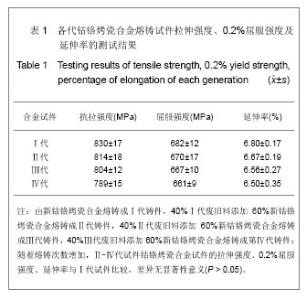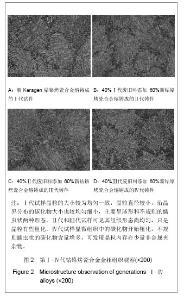| [1] 杨松,程辉,李秀容, 等.反复熔铸对钴铬烤瓷合金力学性能影响的研究[J].华西口腔医学杂志,2011,29(3):249-252.
[2] 邓再喜,王宝成,张少锋,等.反复熔铸对Ni-Cr烤瓷合金机械性能的影响[J].实用口腔医学杂志,2004,20(6):743-746.
[3] 张长源,连颂峰,吴维青,等.多次熔铸对Ni-Cr烤瓷合金拉伸性能的影响[J].福州大学学报:自然科学版,2009,37(4):551-554.
[4] Issac L,Bhat S.Effect of re-using nickel-chromium alloy on its ultimate tensile strength,yield strength and modulus of elasticity.Indian Dent Res.1998;9(1):13-17.
[5] Peraire M,Martinez-Gomis J,Anglada JM,et al.Effects of recasting on the chemical composition, microstructure, microhardness,and ion release of 3 dental casting alloys and titanium.Int J Prosthodont.2007;20(3):286-288.
[6] 王颖卉,连颂峰,程辉,等.反复熔铸对镍铬烤瓷合金硬度的影响[J].福建医科大学学报,2010,44(3):199-201.
[7] Horasawa N,Marek M.The effect of recasting on corrosion of a silver-palladium alloy.Dent Mater.2004;20:352-357.
[8] Bauer JR,Loguercio AD,Reis A,et al.Microhardness of Ni-Cr alloys under different casting conditions.Braz Oral Res.2006: 20(1):40-46.
[9] 朱松,于德珍,赵华,等.不同环境对多次铸造钴铬合金机械性能的影响[J].现代口腔医学杂志,1998,12(1):27-29.
[10] 程辉,陈南,陈百欣,等.牙科用非贵金属高熔铸造合金铸造前后金相比较研究[J].口腔医学纵横,2000,16(3):225-226.
[11] 熊美萍,张静露,袁广银.不同比例的新旧钴铬合金机械性能的研究[J].临床口腔医学杂志,2000,16(1):24-26.
[12] 李旬科,张寿华,沈丽娟,等.贵金属烤瓷合金反复多次熔铸后金相学比较观察[J].口腔医学研究,2002,18(5):310-312.
[13] Hong JM,Razzoog ME,Lang BR.The effect of recasting on the oxidation layer of a palladium-silver porcelain alloy. J Prothet Dent.1988:59(4):420-425.
[14] 周敏,牛开源,黄林.X线探伤法检查牙科铸造体内部缺陷探讨[J].实用口腔医学杂志,1991,7(1):48-49.
[15] 曹洪喜,张建中,丁伟山,等.热处理对自研牙科贵金属合金铸件机械性能的影响[J].口腔材料器械杂志,2002,11(2):69-72.
[16] Alander P,Lassila LV,Vallittu PK. The span length and crosssectional design affect values of strength.Dent Mater. 2005;21(4):347-353.
[17] 宋维锡.金属学[M].北京:治金工业出版社,1980:1-6.
[18] 潘鑫,张晓东,李玉洋.修复体高熔合金材料钴铬合金铸造后性能研究[J].黑龙江医药科学,2001,24(3):13-15.
[19] Harcourt HJ.The Remelting of Cobalt-chromium Alloys.Bri Dent J.1962;112:198-204.
[20] Al-Hiyasat AS,Darmani H.The effects of recasting on the cytotoxicity of base metal alloys.J Prothet Dent.2005; 93(2): 158-163.
[21] Mirkovic N.Effect of recasting on the elastic modulus of metal-:ceramic systems from nickel-chromium and cobalt-chromium alloys.Vojnosanit Pregl.2007;64(7):469-473.
[22] Ozdemir S,Arikan A .Effect of recasting on the amount of corrosion products released from two Ni-Cr base metal alloys.Eur J Prosthodont Restor Dent.1998;6(4):149-153.
[23] Bombonatti PE, Barros LE,Scaranelo RM,et al.Influence of recasting on the castability of copper-aluminum alloys.Rev Odontol UNESP.1988;17(1):169-173.
[24] Mosleh I,Abdul-Gabbar F,Farghaly A.Castability evaluation and effect of recasting of ceramo-metal alloys.Egypt Dent J.1995;41(4):1357-1362.
[25] 陈治清.口腔材料学[M].3版.北京:人民卫生出版社,2008:13-23.
[26] Graig RG,Powers JM.口腔生物力学材料[M]. 11版.世界图书出版西安公司,2006:44-117,291-382.
[27] Schrefer J.Contemporary fixed prosthodontics.Ed 5.St.. Louis, the Mosby Co,2001:488-512.
[28] 罗渌萍,张春元,胡咏大,等. 高熔合金可摘铸件表面缺陷的原因分析及对策[J].口腔医学纵横,1996,12(4):252.
[29] 李红长.高熔铸件产生气孔的原因和预防方法[J].口腔医学, 1993, 13(2):97.
[30] 陈治清.口腔材料学[M].4版.北京:人民卫生出版社,2005:11-23, 143-174.
[31] 赵铱民.口腔修复学[M].6版.北京:人民卫生出版社,2008:164.
[32] Harold FM,Block MJ,Said JM,et al.Influence of polishing of cast clasp.Pros thet Dent.1986;55(1):123.
[33] Hesby DA,Kobes P,Garver D,et al.Physical properties of a repeatedly used nonprecious metal alloy.J Prothet Dent. 1980; 44(3):291-293. |



